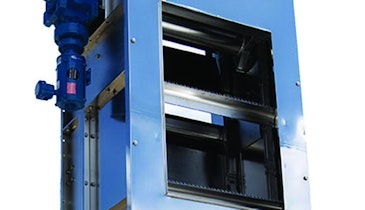
Interested in Headworks?
Get Headworks articles, news and videos right in your inbox! Sign up now.
Headworks + Get Alerts
It’s one thing for a clean-water plant to receive septage. It’s another to do it with high efficiency and positive cash flow, and with no disruption to the treatment process.
John Olson, P.E., gave a formula for optimizing septage acceptance and handling during a seminar at the 2016 Water & Wastewater Equipment, Treatment & Transport (WWETT) Show in Indianapolis last February.
Olson, a regional sales manager with Lakeside Equipment Corporation, described essential features of septage acceptance stations, the benefits and pitfalls of different types of hauled wastewater, and the basis for setting fees that reflect the true cost of receiving, handling and treating the material.
“The septage acceptance plant requires a heavy-duty design,” Olson said. “It should be fully automated so haulers can come in, swipe a card, and discharge their load. The decision to accept any hauled material becomes the plant operators’ responsibility. Therefore, the basic design should be customized to their needs.”
Defining septage
Olson’s presentation treated the term “septage” broadly to include a variety of liquid wastes. “Septage includes septic tank waste, cesspool waste and holding tank waste,” he said. “Every year, 5.5 billion gallons of septage are created in the United States from the equivalent of 24.6 million households.” He described six sources of material with potential to be delivered to a treatment facility’s septage acceptance plant:
- Residential waste, generally consistent and predictable in character.
- Commercial waste, typically high in oils and grease from restaurants.
- Waste activated sludge from other treatment works.
- Industrial waste, highly variable from one industry to another; these wastes must be tested for toxicity in the process and most likely require pretreatment.
- Landfill leachate, also site specific, potentially toxic and in need of testing and pretreatment.
- Portable restroom waste, typically high in ammonia and total nitrogen, and often containing bottles and other large objects.
Impacts on treatment
Olson stressed the need to understand the character of material delivered. To illustrate, he showed a table comparing domestic wastewater treatment plant influent to much-higher-strength household septage. His figures (Table 1) showed that septage contains, for example, 80 times the concentration of grease and 17 times the concentration of total nitrogen as typical wastewater.
To avoid upsets, he observed, it is essential to meter the hauled waste into the plant process instead of introducing it as a slug load. That means adding a holding tank to store the material and an automatic metering system. “It’s important to consider the effective load on the plant,” Olson said. “The effective load reflects how fast that load is added to the process.
“Consider a 3,000-gallon truckload containing 50 pounds of TSS. If that load is discharged into the plant in 15 minutes, you have a multiplier of 96 for that load. Your effective TSS load for that 3,000 gallons is 4,800 pounds. So you have to consider metering to reduce the effective load. If you select eight hours as the metering time and meter the load in overnight, when plant loadings are lower, your effective load multiplier is 3-to-1. You can handle that.”
Station attributes
Olson observed that septage receiving stations are increasingly sophisticated. Years ago, he said, they included little more than 1-inch bar screens and no grit or grease removal. Systems were manually operated and labor intensive; they discharged screened septage directly into the treatment stream.
Today’s systems can be configured for extensive pretreatment and with automated operation, requiring minimal attention from treatment plant staff. They are made of stainless steel for corrosion resistance and are fully enclosed to control odors. Depending on the treatment plant’s specific needs, features can include:
- Rock trap to capture large, heavy objects.
- Fine bar screen, cleaned automatically with a rake mechanism.
- Automated washing, compaction and dewatering process for screenings.
- Screenings bagging system.
- Grit removal and dewatering process.
- Skimming mechanism for grease collection.
- Flowmeter to measure gallons delivered.
- Pneumatic or electrically actuated inlet valves in a variety of sizes.
- Inline pH meter with capability to close the inlet valve if material with pH outside a specific range is detected.
- Chemical addition for pH adjustment.
- Weather protection including tank insulation and heat trace.
- Explosion-proof control panel where warranted.
Accommodating haulers
Given that haulers in many areas can choose where to take septage, Olson cited the importance of easy, convenient access to the receiving station. “Haulers want to be able to unload quickly — that is very critical,” he said.
A typical unloading area includes a 4- or 6-inch inlet valve with quick-connect hose hookup and an emergency stop switch. High-traffic plants can include dual systems that enable two trucks to unload at the same time. “The haulers operate the system by swiping a card or entering an ID number,” said Olson. “The treatment plant operator doesn’t have to be outside to run the equipment.”
The systems can include a touch-screen human machine interface (HMI) that lets plant operators know when a hauler is using the station; an on-screen emergency stop button is provided. The system can be configured to issue the hauler a customized invoice or to securely accept credit card payment and print a receipt.
For larger facilities, data management and accounting capability can be added, collecting the hauler name, hauler ID number, unloading start time and date, unloading duration, waste type, gallons delivered, and other information. Plant managers can then download the stored data for review.
Pricing it right
The most essential aspect of receiving septage is charging a fair fee. Here, flow metering is critical. So are an analysis of the waste delivered and understanding the true costs of treatment. The first step is to calculate the pounds of BOD, TSS, nitrogen and phosphorus in a given truckload. Actual treatment costs vary from one plant to another. Components of those costs and thus the fee charged should include:
- A flow charge per gallon for the truckload, reflecting the basic costs of capacity and depreciation of plant equipment.
- Pounds of TSS multiplied by the dollars to remove each pound received.
- Pounds of BOD multiplied by the dollars per pound to provide oxygen for aeration.
- Net biosolids yield multiplied by the dollars to stabilize and process the material and haul it to its final destination.
- Pounds of nitrogen multiplied by the dollars per pound to provide oxygen for aeration.
- Pounds of phosphorus multiplied by the dollar cost of chemicals used per pound removed (plus an adder for depreciation on the chemical feed equipment).
The total of those cost components provides a sound basis for establishing fees for waste haulers, Olson said.
The bottom line: An efficient process for receiving and handling hauled waste, combined with an appropriate fee structure, can enable clean-water plants to offer a valuable service to their communities and generate revenue for plant upkeep, equipment replacements and upgrades needed to maximize performance and maintain consistent permit compliance.





